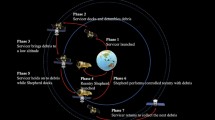Abstract
Successive missions must be planned to clean the near-Earth space from the heaviest debris. The problem mixes combinatorial optimization to select and order the debris, and continuous optimization to define the orbital maneuvers. In order to reduce the costs all missions have to be achieved by identical expendable vehicles with a minimum fuel requirement. The solution method proposed consists in three stages. Firstly the orbital transfer problem is solved for all pairs of debris and for discretized dates, considering a generic transfer strategy suited either to a high-thrust or to a low-thrust vehicle. The results are stored in cost matrices defining a response surface. Secondly a simulated annealing algorithm is applied to find the optimal mission planning. The cost is assessed by interpolation on the response surface. The convergence is quite fast, yielding an optimal mission planning. Thirdly the successive missions are re-optimized in terms of transfer maneuvers without changing the debris order. These continuous problems yield a refined performance requirement for designing the removal vehicle. The solution method is illustrated on a representative application case.








Similar content being viewed by others
Abbreviations
- LEO:
-
Low earth orbit
- SSO:
-
Sun-synchronous orbit
- RAAN:
-
Right ascension of ascending node
- SDC:
-
Space debris collecting
- TSP:
-
Travelling salesman problem
- RSM:
-
Response surface modeling
- SA:
-
Simulated annealing
- NLP:
-
Nonlinear programming
References
Position paper on space debris mitigation. International Academy of Astronautics (2005)
Klinkrad, K. (s.d.): Space debris models and risks analysis. ISBN:3-540-25448-X
Liou, J.: An assessment of the current LEO debris environment and what needs to be done to preserve it for future generations (2008)
Walker R., Martin C.E., Stokes P.H., Wilkinson J.E. : Studies of space debris mitigation options using the debris environment long term analysis (DELTA) model. In: 51st International Astronautical Congress, Brazil, pp. IAA-00_IAA.6.6.07. Rio de Janeiro (2000)
Nemhauser, G.L., Rinnooy Kan, A.H.G., Todd, M.J.: Optimization. In: Handbooks in Operations Research and Management Science, vol. 1. Elsevier, Amsterdam (1989)
Dréo J., Pétrowski A., Siarry P., Taillard E.: Métaheuristiques Pour l’optimisation Difficile. Eyrolles, Paris (2003)
Schneider, J.J., Kirkpatrick, S.: Stochastic Optimization. Springer, Berlin (2006)
Cerf, M.: Multiple space debris collecting mission, debris selection and trajectory optimization. J. Optim. Theory Appl. 156, 761–796 (2013). doi:10.1007/s10957-012-0130-6
Braun, Vitali, Lüpken, A., Flegel, S., Gelhaus, J., Möckel, M., Kebschull, C., Wiedemann, C., Vörsmann, P.: Active debris removal of multiple priority targets. Adv. Space Res. 51, 1638–1648 (2013)
Barbee, B.W., Alfano, S., Piñon, E., Gold, K., Gaylor, D.: Design of spacecraft missions to remove multiple orbital debris objects. AAS 12-017. In: 35th Annual AAS Guidance and Control Conference (2012)
Zuiani, F., Vasile, M.: Preliminary design of debris removal missions by means of simplified models for low-thrust many revolution transfers. Int. J. Aerosp. Eng. 836250 (2012)
Olympio, J.T., Frouvelle, N.: Space debris selection and optimal guidance for removal in the SSO with low thrust propulsion. Acta Astronaut. 99, 263–275 (2014)
Stuart, J., Howell, K., Wilson, R.: Application of multi-agent coordination methods to the design of space debris mitigation tours. In: 24th International Symposium on Space Flight Dynamics (2014)
Chobotov, V.: Orbital Mechanics, 3rd edn. AIAA Education Series (2002)
Vallado, D.A.: Fundamentals of Astrodynamics and Applications, 3rd edn. Space Technology Library (2007)
Leitmann, G.: Theory of maxima and minima. In: Optimization Technique with Applications to Aerospace System. Academic Press, New York (1962)
Conway, B.A.: Spacecraft Trajectory Optimization. Cambridge University Press, Cambridge (2010)
NORAD Two Line Elements. http://www.celestrak.com/NORAD/elements/
Acknowledgments
This work was carried out at Airbus Defence and Space in 2013–2014 in the frame of the internal R&D. I would like to thank the R&D team project for having supported this work.
Author information
Authors and Affiliations
Corresponding author
Rights and permissions
About this article
Cite this article
Cerf, M. Multiple Space Debris Collecting Mission: Optimal Mission Planning. J Optim Theory Appl 167, 195–218 (2015). https://doi.org/10.1007/s10957-015-0705-0
Received:
Accepted:
Published:
Issue Date:
DOI: https://doi.org/10.1007/s10957-015-0705-0




